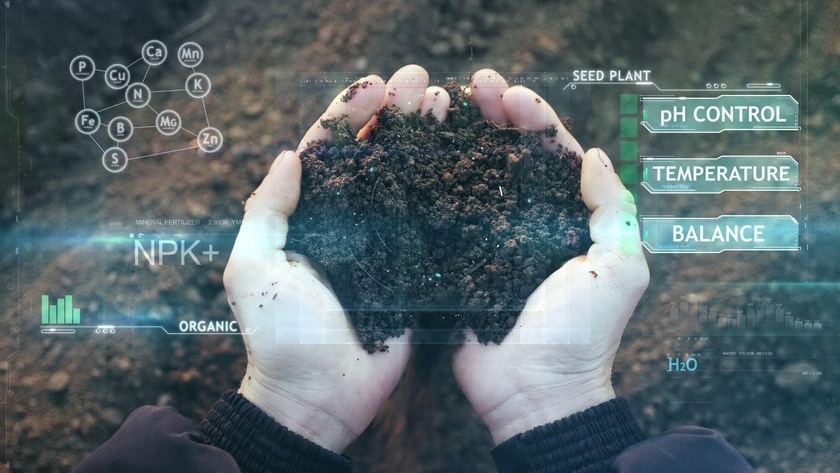Soil is a complex system that possesses fertility, i.e. the ability to support the growth and productivity of plants, hence crop production. And nowadays, it is difficult to imagine soil management without the use of fertilizers. However, few farmers think about the advisability of their application, effectiveness, and the need for plants in them.
That is why the first step towards smart soil fertility management and preservation is a chemical analysis of the soil for its main agrochemical indicators (nutrients, humus content, pH value, etc). This analysis makes it possible to objectively assess the potential of soil fertility, the level of supply of macronutrients, acidity of the soil, and more. Relying on the results of this analysis, growers can decide on performing soil conservation practices. But before we move on to those soil fertility preservation methods, let’s briefly go through the main soil degradation issues and their causes.
Most Common Soil Degradation Problems
Here are the most dangerous and frequent soil health issues that most farmers encounter on their fields.
Soil Erosion
Erosion of soil is a process during which the upper, most fertile soil layer is destroyed and carried away (usually by wind or water flows). Depending on the causes of soil decomposition, soil erosion is divided into natural and accelerated (anthropogenic). Natural soil erosion lasts for 2-7 millennia. But with accelerated erosion, the degradation of the topsoil can occur in 1-3 decades. It is caused by irrational human economic activity, which activates and enhances natural erosion. Among the reasons for accelerated erosion are improper tillage and irrigation of the soil, its excessive fertilization, deforestation, uncontrolled livestock breeding, and drainage of swamps.
Soil erosion occurs under the influence of either water or wind. Wind erosion is a process in which tiny soil particles are blown out and carried away by the wind. The strongest and most prolonged winds develop into dust storms. In a few days, they are able to completely demolish the topsoil. And water erosion is a process when the topsoil is destroyed and washed off by heavy rainfall and flooding.
Soil Salinization
Soil salinization is a complex process in which sulfates, chlorides, and carbonates accumulate in soil above the norm. As a result, the soil loses its properties. All plants that were planted in such soil die off. In addition, the excess amount of salt in the ground leads to a number of negative consequences. Further use of such soil is not possible. It deprives even unpretentious crops of vitality. In addition, plants growing in the adjacent territories are also endangered. Saline soils harm not only plants but also insects.
There are 2 types of soil salinization: natural – when various natural phenomena cause the salts to rise from groundwater to the surface, and anthropogenic – when improper use of irrigation systems causes high humidity which provokes a rapid increase in groundwater levels so the salt rises up and accumulates on the surface.
Soil Compaction
Heavy combines, tractors, and other heavy machinery compact the soil causing its biological activity, porosity, and permeability to reduce. Loss of permeability leads to depletion of water reserves and drying of roots. Compaction of the soil reduces the resistance of plants to droughts, and in case of heavy rains, it causes water erosion, since the soil is incapable of absorbing the excess moisture.
Soil Conservation Practices
Here are the ways that help prevent the above described issues from happening, protecting and saving the soil through smarter management practices.
Crop Rotation
Crop rotation significantly reduces soil depletion and prevents pests outbreak. Due to this, again, the need for the use of agrochemistry is reduced. Correct crop rotation is a scientifically based rotation of crops and fallow over time and placement in the fields with the aim of increasing soil fertility, reducing the threat of diseases and pests, and mitigate the harmful effects of wind and water erosion on soil.
Manuring
If you cannot get the required amount of natural fertilizers, they can be successfully replaced with green manure plants. When their green mass reaches its maximum value, green manure is simply plowed in the field as fertilizer.
Mulching
Mulching is an effective agricultural technique, which consists in the formation of a loose, moisture-saving, surface layer by constantly loosening the soil or covering it with a layer of special materials (mulch) to protect and improve its properties.
In industrial agriculture, this technology is rather difficult to apply, since it requires special equipment and increased labor costs, but in a private garden or field, this method is very effective. Mulching is very good at helping to combat wind and water erosion, and also helps to retain moisture in the soil.
Reduced Tillage
Cultivating agricultural land after each harvest disrupts the soil and reduces its ability to retain water. Reduced tillage or no-till means the soil tillage is minimized or the soil is left completely untouched. In this case, the residues of the last crop (green manure) decompose in the ground, providing the soil with nutrients and organic content and suppressing weeds, naturally reducing the need for tillage.
Overall, smart soil management enables not only better soil fertility and higher yields but also resources preservation and cost-effectiveness. More so, soil conservation practices are also the most sustainable solutions when it comes to tackling soil degradation issues.



